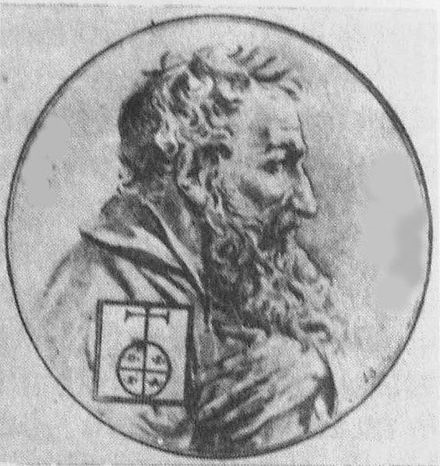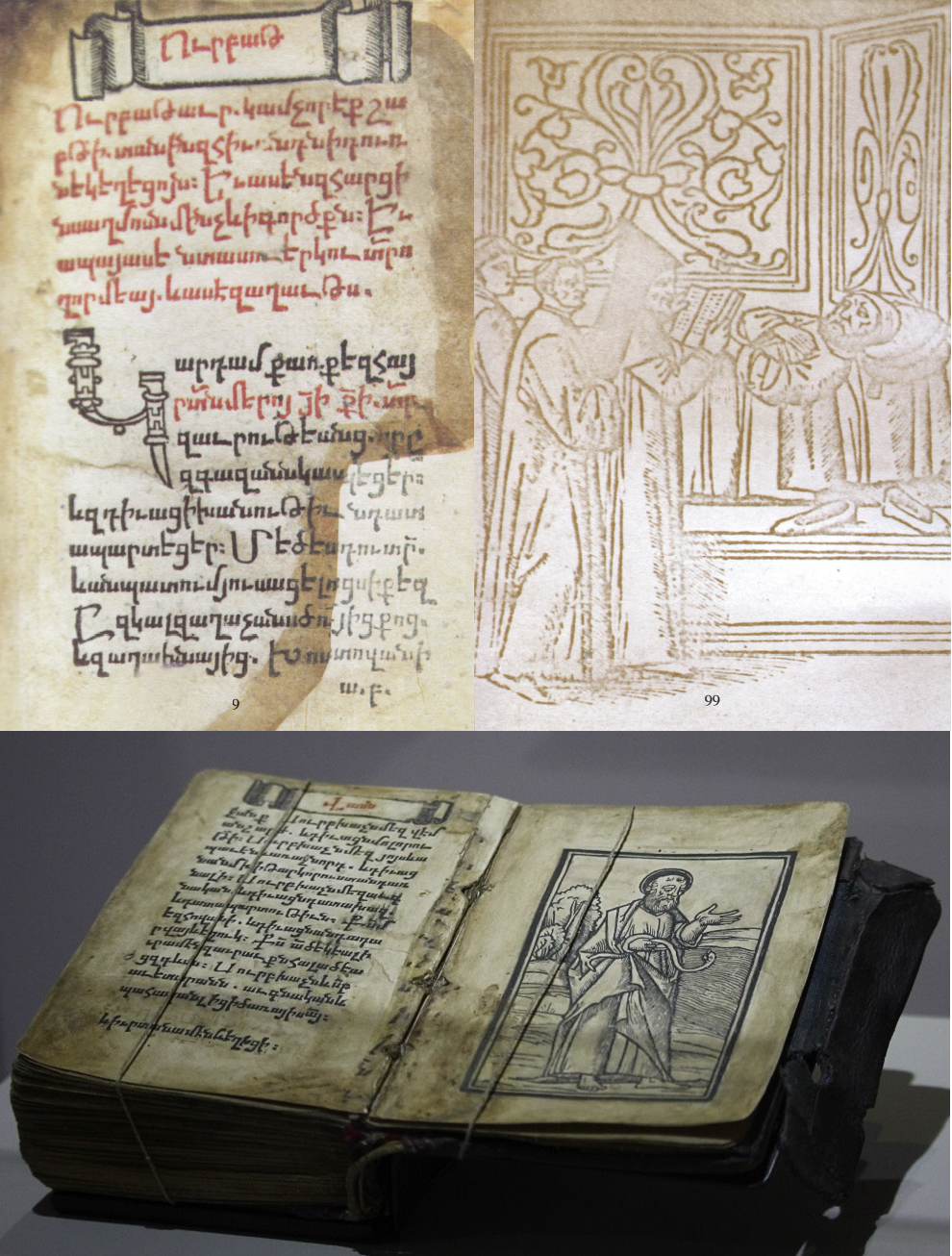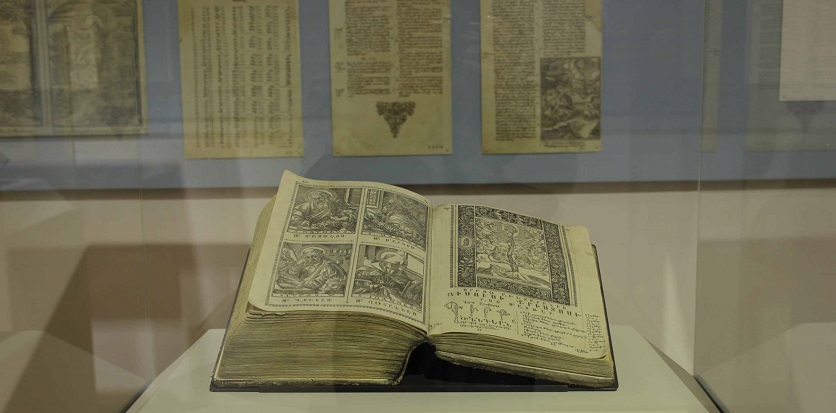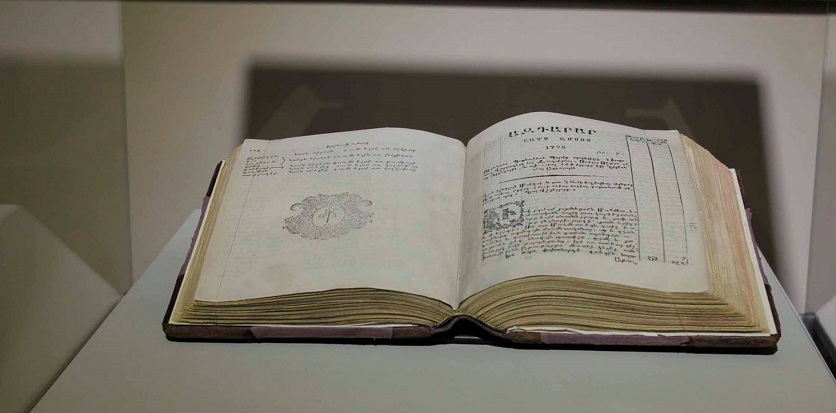From Earth to space: Fabulous firsts brought to light at the Museum of Printing in Armenia
May 16, 2022
What type of images come to mind when you think of a printing museum in Armenia? Bibles and antique books? Printing machines and clichés? A collection of pioneering newspapers from every corner of the Armenian world? It’s probably not some specially processed moonlight-tinted parchment highlighting the Armenian alphabet for a mighty voyage from Earth to space; something more analogous to “louys tesav” (լոյս տեսա՝ւ) or seeing the light of day—pun intended!
At h-pem we celebrate the International Day of Light (May 16th) and the International Museum Day (May 18th) by going back to the first dawn of Armenian printing that ushered in the great epoch of Armenian enlightenment and national awakening.
A modern Armenian scroll, bearing a copy of the first Armenian printer’s seal, was taken on a cosmic trip across our solar system on the occasion of the 500th anniversary of Armenian printing in 2012. After staying in space for three weeks, the calligraphic specimen found its permanent home in the Museum of Printing established in the National Library of Armenia (NLA.)
This may sound like a fairy tale, but it is fitting metaphor to the spirit of Armenian merchants who used their fifth-century script to chart the seas and map the deserts in their hunt for new markets and cutting-edge knowledge. The legacy they left behind is their contribution to Armenian culture, education, and letters.
The first Armenian book, the first Armenian newspaper, even the first Armenian constitution were printed thousands of kilometers away from the Motherland, while it took three centuries to establish a printing press in Armenia…
In his book "From the Indian Ocean to the Mediterranean: The Global Trade Networks of Armenian Merchants from New Julfa,” Dr. Sebouh Aslanian offers a mind-blowing statement on the epic journey of Armenian printing:
“This Perso-Armenian community of merchants in India provided the social and economic foundations for what has come to be known in Armenian historiography as the “national revival movement” in the diaspora. They bankrolled the nascent craft of Armenian printing in places like Venice, Amsterdam, Livorno, Madras, Calcutta, Lvov (now in the Ukraine), and New Julfa. They were also behind the revival of letters then spearheaded by a small band of Armenian Catholic missionaries known as the Mkhitarist Order, based on the island of San Lazzaro in Venice; they supported the establishment of schools of higher education in Venice, Paris, New Julfa, Moscow, and Calcutta. In addition to their financial patronage, some members of the Julfan merchant community became cultural and intellectual producers in their own right.”
.jpg) Entering the Printing Museum through a side door on Teryan Street in Yerevan is like taking a step into an austere temple of enlightenment.
Entering the Printing Museum through a side door on Teryan Street in Yerevan is like taking a step into an austere temple of enlightenment.An austere temple of enlightenment
Entering the Printing Museum through a side door on Teryan Street in Yerevan is like taking a step into an austere temple of enlightenment. A priceless collection, displayed in a series of themed exhibits, pays tribute to one of the most significant trends in Armenian printing: the first printed books were not only religious and astrological but also practical and medical in nature. Over time, affected by the rise of Humanism, there was growing interest in textbooks, languages, and translations of Western classics.
In her tiny office, deep inside the massive library building, where millions of Armenian books, newspapers, and periodicals are being digitized at an increasing pace to ensure preservation and accessibility, Haykanush Ghazaryan, Deputy Director for Science at the National Library of Armenia, is no stranger to the magical power of books.
“Where do you think the idea of drones or flying carpets come from?” she reflects, during a brief chat with h-pem. “Upon visiting the museum, children marvel at the cosmic artifact and come up with their own science fiction and fantasy stories; the entire collection of mystical tomes hold them spellbound.”
When confronted with current discussions of digital exposure and the demise of traditional print across generations, Ghazaryan is quick to point out that the museum is crucial for the preservation and transmission of cultural memory.
“While it is impossible to stop the constant influx of people and ideas and the fusion of cultures, cultural knowledge gives us the power and freedom we need to make better choices. We don't have the right to impose our values and preferences on our children, but we can offer credible resources to make comparisons. I believe in the museum effect, in the power of books and the written word as a way of steering our future,” she says.
The “red thread”
It’s worth taking a lesson or two from history to consider the enduring impact of printing on the Armenian world.
“Even centuries ago, Armenian thinkers emphasized the importance of languages not only for effective communication and progress, but also as a means to learn about other cultures and nurture their own culture,” explains Ghazaryan.
 Hakob Meghapart (Jacob the Sinner), who established the first Armenian printing press in Venice in 1512.
Hakob Meghapart (Jacob the Sinner), who established the first Armenian printing press in Venice in 1512. One of the first five books printed in Armenian was “Tagharan” (“Տաղարան” | Song Book), an extensive collection of medieval poems and riddles, published by Hakob Meghapart (Jacob the Sinner), who established the first Armenian printing press in Venice in 1512.
For Ghazaryan this shows how important poetry and creativity were to the first publishers of Armenian books. "It signals our cultural presence on the world stage,” she states.
Does the museum open up new possibilities for thought and action?
“Look,” she says, drawing inspiration from the establishment of the First Republic of Armenia three years after the Armenian Genocide. “There were starving refugees on the freezing streets of Yerevan, diseases and pandemics, but there was still another level to reach. Even in those catastrophic circumstances, the first leaders of the republic were aware of the pivotal role of higher education in the newly emerging country. They founded a university and issued a two-page newsletter—it was not just an inaugural publication, but offered an amazing wealth of information. They created an army, and published a newspaper called “Banaki Or” (“Բանակի Օր” | Army Day). This newspaper runs like a red thread through our culture and our values—nation, army, people. The first key notion of patriotism is cultural memory.”
“The Firsts of Armenian Printing Hall” is the museum’s heart, where exquisitely illustrated copies of the first printed Armenian map, the first book of arithmetic, the first draft of Armenian constitution, and the first healing book— printed even before the Armenian Bible—shed light into the dawn years of Armenian enlightenment.
Check out 5 fabulous firsts in Armenian printing below!
“Urbatagirk” (“Ուրբաթագիրք” | “The Book of Fridays”)

Half a century after Gutenberg's invention of the printing press, the first book printed in the Armenian language was “Urbatagirk.” In the medieval times, manuscripts of the “Urbatagirk” were used to ward off evil and heal the sick. Written in Grabar (Classical Armenian), it contains both sacred and secular texts—prayers, spells, spiritual poems, remedies, blessings, stories about saints, as well as excerpts from Gospels and the “Book of Lamentations” by Gregory of Narek. The texts are printed in black and red cursive script, with blank spaces left for the owner's name—intended as a protection against demons and magic. The book is illustrated with wood engravings: a priest is depicted holding a snake in healing ritual, and another one holding a book of remedies while attending a patient.
Interesting fact: Why is it “Urbatagirk?” Because Friday is dedicated to the Holy Cross. The book opens with the words: “On Friday or Wednesday they take the sick to the church, and they read the morning psalms all the way through.”
("Urbatagirk" was published by Hakob Meghapart in Venice in 1512).
“Kharnaypntur tumar” (“Խառնայփնթուր տումար” | “Mixed Calendar”)

Fifty-two years after Hakob Meghapart’s publishing house ceased to exist in Venice, Abgar Tokhatetsi or Abgar Dpir (Abgar the Scribe) roamed from Rome to Venice in a futile attempt to find the fonts made by the pioneer of Armenian printing and continue his work. Eventually, following in his predecessor’s footsteps, Abgar commissioned the famous French type designer and printer Robert Granjon to engrave typefaces based on Armenian manuscripts. Abgar’s first publication was a one-page illustrated calendar “Kharnaypntur tumar. geghetsik yev pitani” (Mixed Calendar: Beautiful and Useful)—the first printed Armenian Calendar. It depicts Abgar and his son Sultanshah in Rome, seeking the approval of Pope Pius IV to set up a printing press. Another illustration shows him at an audience with the doge of Venice.
Interesting fact: Abgar Dpir first set foot in Rome as part of a delegation dispatched by the Catholicos Michael Sebastatsi in 1562 on a mission to seek papal support for the Armenian liberation movement and to settle doctrinal issues.
(“Kharnaypntur tumar” was published by Abgar Tokhatetsi in Venice in 1565).
“Hamatarats ashkharhatsuyts” (“Համատարած աշխարհացոյց” | “The World Map”)

A bishop from the Village of Vanand in the Goghtn Province of Nakhichevan, left for Amsterdam in 1693 to establish a printing press with the help of four other Vanandetsis. Two years later they printed the first world map in Armenian by hiring the best Dutch engravers of the time. The map is one of the most advanced and encompassing examples of Renaissance cartography. It shows the world divided into the old world and the new world, with parts of Australia and North America still undiscovered. The two hemispheres are surrounded by allegorical depictions of the four seasons, the zodiac signs, and the names of the planets. The map presents Armenia—both Greater Armenia and Lesser Armenia, and has been a go-to guide on how to convert geographical names into Armenian.
Interesting fact: An explanatory booklet on how to use “The World Map” focused on cities that were major trade centers at the time. It was intended mainly for the information and practical assistance of Armenian merchants.
(“The World Map” was published by Tovmas Vanandetsi in Amsterdam in 1695).
“Arhest hamaroghutyan” (“Արհեստ համարողութեան” | “The Art of Arithmetic”)

The first book printed in Modern Armenian, "Arhest hamaroghutyan," was designed for Armenian merchants. The publisher gives a teaser of what to expect: "To meet the need of Armenian merchants who do not have full mastery of arithmetic, we found it appropriate to translate this book into our own language for those attuned to it, so that they are able to work effectively, without their minds wandering. The book teaches merchants how to use whole numbers and fractions and the rules of arithmetic through very simple examples. It gives an idea about how to make use of different currencies and engage in commercial transactions, and handles other details as well. It is written in modern Armenian style, especially to stop gossipmongers and the work-shy from speculating, who, upon reading this book will overcome all difficulties in the art of calculating."
Interesting fact: "Aritmetica Pratica" by Christopher Clavius, one of the leading mathematicians of his time, formed the basis of “Arhest hamaroghutyan.” It was translated from Latin into the spoken language used by the Armenian merchants of New Julfa.
("The Art of Arithmetic" was published by Soghomon Levonian at the Voskanian press in Marseilles in 1675).
“Vorogayt parats” (“Որոգայթ փառաց” | “Snare of Glory” | Armenian Constitution)

In his book "From the Indian Ocean to the Mediterranean: The Global Trade Networks of Armenian Merchants from New Julfa," Dr. Sebouh Aslanian puts it best when he writes about the creation of the Armenian constitution: "Faced with decreasing prospects of trade in India, some Julfans in Madras began to “reimagine” and reinvent themselves not only as Julfans, but as members of the larger Armenian “nation.” This shift “from coalition to nation,” as I call it, can be seen in the remarkable series of publications published in Madras in the 1770s and 1780s by a small group of Julfan merchants and neo-intellectuals, including Shahamir Shahamirian, in which republican ideas are formulated in a constitutional treatise for a future republic of Armenia that would not exist on a map for another 140 years or so. Thus, instead of reinventing a new mercantile network (as the Multanis appear to have done) with a new nodal center in India, the Julfans there advocated creating an Armenian national state where they hoped to relocate both themselves and their capital."
Interesting fact: The only constitution that predates the Armenian constitution is that of San Marino ratified in 1600. The Armenians drafted and printed a constitution of an independent Armenia more than a decade before the United States created one in 1787.
("Snare of Glory" was published by Shahamir Shahamirian in his printing house in Madras in 1773).
Keep reading to find out 7 things you may not know about other firsts in Armenian printing!
- A medieval glossary, Rasulid Hexaglot or the King’s Dictionary, included Armenian among its collection of the most important languages of fourteenth century Eurasia: Arabic, Persian, Turkic, Greek, and Mongol. For the first time, more than a thousand practical words were compiled by the sixth Rasulid king of Yemen (or his scribe) to facilitate communication between merchants.
- The Armenian alphabet was first printed by Bernhard von Breidenbach, who dedicated a whole chapter to the Armenians in "Peregrinatio in terram sanctam," an account of his pilgrimage to the Holy Land, published in Mainz (Germany) in 1486. The Armenian letters were designed and engraved by the Dutch artist Erhard Reuwich.

- Five thousand copies of the first edition of the Armenian Bible, the "Voskanian Bible" were published by Voskan Yerevantsi in Amsterdam between 1666 and 1668. Three years later Voskan sent a copy of the Bible to Louis XIV and a letter requesting permission to set up a printing house in France. The printing house he founded in Marseilles operated until 1683.
- Johann Joachim Schröder, a German orientalist, was the first European scholar to carry out a comparative study between classical Armenian and the spoken Armenian vernacular and to examine the features of spoken grammar. His book, "Thesaurus linguae armeniacae, antiquae et hodierne" was published in Amsterdam in 1711.
- Movses Khorenatsi’s fifth-century "History of Armenia," which covers the entire span from Late Antiquity to the chronicler’s death in the late fifth century, was the first Armenian book published in London. It was printed by Caroli Ackers in 1736.
- In 1751, the Armenian alphabet was included in one of the principal works of the Age of Enlightenment, the Encyclopédie, by French philosopher Denis Diderot.

- The first Armenian newspaper was published in Madras, where a vibrant Armenian community thrived. In 1794 the priest Haroutyun Shmavonian launched "Azdarar" ("Ազդարար" | Monitor) as a platform of cultural, social, literary, and political expression. Although "Azdarar" was published only for three years, it nurtured the concepts of collective identity and belonging in the Armenian world.
References:
- Aslanian, Sebouh Dr., From the Indian Ocean to the Mediterranean: The Global Trade Networks of Armenian Merchants from New Julfa, University of California Press, 2011, https://www.amazon.com/Indian-Mediterranean-California-History-Library/dp/0520282175
- The Book of Fridays, Library of Congress, https://www.loc.gov/resource/gdcwdl.wdl_11302/?sp=48
- Ռուբէն Գալիչեան, Ամստերդամի “Համատարած աշխարհացոյցը” 1695 Թ., Էջմիածնի գիտաժողով, 2010.
- Ասատուր Փաշայեան, “Արհեստ համարողութեան”-ը հայ հնատիպ գրքի պատմութեան հոլովոյթում, Հայ մատենագրութեան թուանշային գրադարան, 2021. http://www.digilib.am/
All photos are courtesy of the Museum of Printing in Armenia, unless otherwise noted.
Join our community and receive regular updates!
Join now!



Attention!